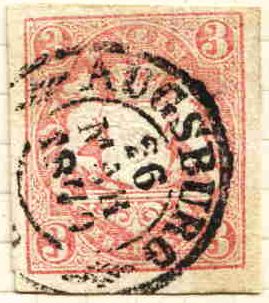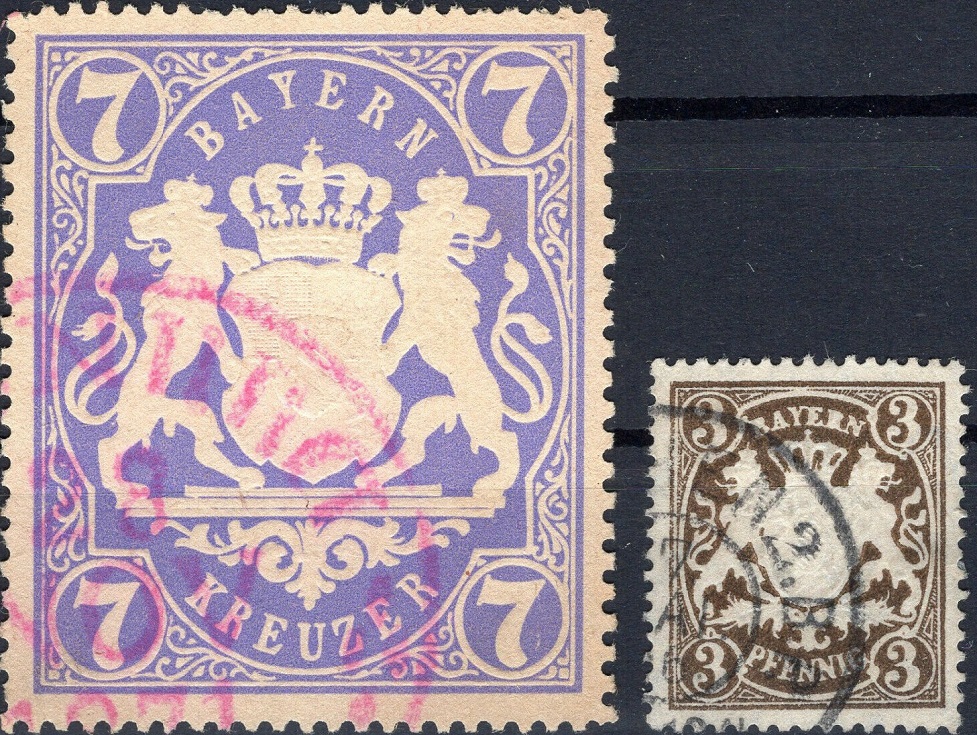 |
|||||
|
|||||
| Preview of Stamps Catalogue: VOLUME 1 |
 |
|||||
|
|||||
| Preview of Stamps Catalogue: VOLUME 1 |
Return To Catalogue - Bavaria - Other German States - Germany
Note: on my website many of the
pictures can not be seen! They are of course present in the catalogue;
contact me if you want to purchase it.
For the Bavaria 1849 issue click here.
1 Kreuzer green 3 Kreuzer red 6 Kreuzer blue 6 Kreuzer brown (1868) 7 Kreuzer blue (1868) 9 Kreuzer brown 12 Kreuzer lilac 18 Kreuzer red
For the specialist, as the previous issue, these stamps have silk threads, the threads were no longer applied in the 1875 perforated issue. These stamps were issued on 1st January 1867. They were printed in sheets of 60. The 7 k value was used on letters to the North German Confederation, Wurttemberg and Baden, but was also later used on letters to Belgium and Denmark. As a result of this, to avoid confusion, the color of the 6 k was changed from blue to brown.
Value of the stamps |
|||
vc = very common c = common * = not so common ** = uncommon |
*** = very uncommon R = rare RR = very rare RRR = extremely rare |
||
| Value | Unused | Used | Remarks |
| 1 k | *** | * | |
| 3 k | *** | vc | |
| 6 k blue | *** | *** | No longer valid after 1 October 1868 (to avoid confusion with 7 k blue). |
| 6 k brown | *** | *** | Issued 1 October 1868. |
| 7 k | RRR | ** | Issued 1 October 1868. |
| 9 k | *** | *** | No longer valid after 1 October 1868 (to avoid confusion with 6 k brown). |
| 12 k | RRR | R | |
| 18 k | R | R | |
The values 2 k green and 10 k brown are cut-outs from postal stationary (the 6 k brown and 12 k lilac also exist as postal stationary). I've seen a 7 k blue postal stationary, but with the upper "7"s replaced by posthorns.


7 k blue postal stationary, with the upper "7"s
replaced by posthorns.
Special cancels:



Halbkreisstempel (half circle), Doppelkreisstempel (double circle
cancle) and Postablage cancel (branch office cancel)
Forgeries exist of this issue, example:
A forged 7 k blue stamp is described in the booklet by the German Philatelic Society, in which the embossing is missing and the cancel has been printed (always? MUENCHEN 31 DEC).
Private reprint, made by Peter Sem, the author of a specialized Bavaria catalogue:


Zoom-in of the stamp on this mini-sheet, the embossing has also
been reproduced, this reprint has no silk thread.

1 k green 3 k red 6 k brown 7 k blue 9 k (1873) 10 k yellow (1873) 12 k lilac 18 k red

(A full sheet with watermark 'wavy lines')
These stamps do no longer have silk threads. For the specialist; the values 1, 3, 7, 10 and 18 kr have also been printed on paper with watermark wavy lines, they are much cheaper uncanceled than canceled (because of the introduction of the Mark on the 1st January 1876 they became obsolete)! The other watermark of this serie is lozenges. Specialists distinguish between lozenges of 17 and 14 mm, though both sizes co-exist on the same sheet. These stamps were printed in sheets of 60 stamps. The 9 k value was introduced for letters to France, Great Britain, Norway, Portugal, Spain, Constantinopel and the United States (through Bremen or Hamburg). The 10 k value could be used on letters for Italy, Russia, Sweden, Turkey, Alexandria and the United States (through Cologne). Source: "The Stamps of the German States" by Bertram W.H.Poole (also downloadable from http://www.archive.org).
Value of the stamps |
|||||
vc = very common c = common * = not so common ** = uncommon |
*** = very uncommon R = rare RR = very rare RRR = extremely rare |
||||
| Value | Watermark 'lozenges' | Watermark
'wavy lines' (November 1875) |
Remarks | ||
| Unused | Used | Unused | Used | ||
| 1 k | * | c | vc | * | |
| 3 k | ** | vc | vc | * | |
| 6 k | *** | *** | |||
| 7 k | * | * | c | *** | |
| 9 k | c | * | Issued 1st January 1873 | ||
| 10 k | * | ** | Issued 1st January 1873 | ||
| 12 k | RRR | RRR | Withdrawn 31 December 1872 | ||
| 18 k | ** | ** | ** | *** | |
The so-called millwheel cancels 'Mühlradstempel' were not applied to this perforated stamp set, since these cancels were withdrawn on 9 March 1869.
Reprints were made for the Wiener Weltaustellung (Vienna World Exhibition) in 1873, these reprints, or actually, special prints, were printed very neatly especially for this occasion. Examples:



Certified genuine 'Vienna exhibition' reprints, note the lozenges
watermark on the 1 k block.
Example:


Forged 12 k stamp, I have no further information
It might be that the above forgery is a postal stationery, possibly thinned, with forged perforation. I know of the existence of such forgeries. The perforation does in many cases not correspond to the genuine perforation and the color of the 'stamp' is then too dark.
Forged cancels exist on the stamps with watermark 'Wavy Lines', since uncancelled stamps are less rare than cancelled stamps with this watermark.

I've been told that this is a forged cancel on a 12 k stamp
In March 1877, the stamp dealer Georg Zechmeyer in
Nurnberg obtained all remainders of 1849-1875 Bavarian stamps and
postal stationery. He acquired 3 1/2 Million stamps (source:
'Philatelic Forgers, their Lives and Works' by Varro E.Tyler).
Before this, in 1869, many remainders were already sold to
W.Faber & Co in Heidelberg (source: 'Handbuch der Neudrucke'
by Paul Ohrt) for 180810 Kreuzer (=3013 1/2 Gulden). The book of
Meyer says that Faber obtained remainders of the 1850 issue (3 k
blue, 1 k red, 6 k brown, 9 k green, 12 k red and 18 k yellow);
not this issue. See also "The Stamps of the German
States" by Bertram W.H.Poole (also
downloadable from http://www.archive.org). This is the reason
that many uncancelled stamps are more common than cancelled
stamps of this area. See also the "Handbuch für
Postmarkensammler für den permanenten Gebrauch Bestimmt
(1881)" by Ferdinand Meyer.
The book of Poole mentions that following remainders were bought
be Zechmeyer:
1 k: 942,000 stamps (watermark wavy lines)
3 k: 1,470,000 stamps (watermark wavy lines)
6 k: 171,600 stamps,
7 k: 321,000 stamps (watermark wavy lines)
9 k: 174,000 stamps
10 k: 120,000 stamps (watermark wavy lines)
12 k: 3,000 stamps
18 k: 99,000 stamps (watermark wavy lines).

Advertisement label of Zechmeyer, showing a 12 k stamp with
inscription (in German): 'Originals from the Bavarian postal
administation, obtained on 27 February 1877, for sale, stamp
dealer G.Zechmeyer, Nurnberg'.

I posess this 7 Kreuzer stamp, which is about twice the size as a
normal stamp. I'm not sure what this stamp was used for (it has
embossing and a pink cancel). My personal copy has the cancel a
bit clearer and positioned slightly higher "?N??? 28 NOV
1871".
For the same stamps, but with value in "PFENNIG" click here.